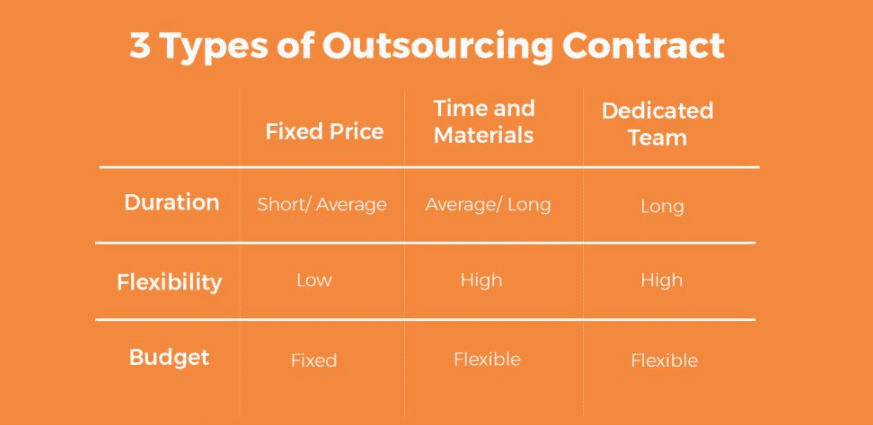The Dos And Don’ts Of A Software Development Contract
When selecting an outsourcing partner for software development, finalizing the contract marks a crucial step. Regardless of a company’s size, outsourcing offers potential benefits for businesses. Instead of managing an in-house development team, outsourcing can provide cost savings, allowing you to allocate resources more efficiently towards your core business strategies.
However, rushing into partnerships often leads to overlooked details and loopholes in software development agreements. Have you considered the true cost of an ideal contract for software development? Avoiding numerous common mistakes is essential. Our article aims to provide you with insights into crafting a robust software development contract, crucial for effective software development planning.
What Is A Software Development Contract?
A software development contract is a foundation of trust and clarity between a client and a developer or development firm. This legally binding document clearly outlines the project’s scope, timelines, costs, deliverables, and mutual responsibilities. Think of it as a success blueprint, ensuring both parties are aligned and aware of their commitments throughout the software development process.
With the outsourcing industry booming—reaching US$541.10bn in 2024—the demand for such contracts is on the rise. Companies worldwide are reaping the benefits of outsourcing, such as cost reduction and access to diverse talent, without expanding in-house teams.
A software development contract is more than just a formality; it’s a strategic tool. It guides you through vendor selection with due diligence and clarifies payment structures and rate expectations. Whether your project has clear requirements or needs client-led direction, the contract helps outline a detailed timeline and scope. This not only sets the stage for efficient development but also fosters a shared vision, allowing all involved to work towards a common goal with a unified strategy while also adhering to software compliance standards.
Why Software Development Contract Is Important?
Understanding the importance of a Software Development Contract is crucial in the tech industry. It’s more than just a formality; it’s a strategic framework that ensures clarity and transparency. These agreements meticulously detail the project’s scope, deliverables, and timelines, reducing misunderstandings and aligning expectations, which is essential in the fast-evolving landscape of software development trends.
For both freelancers and companies, navigating software development comes with inherent risks. A robust agreement acts as a risk management tool, outlining responsibilities and setting a clear path for dispute resolution. It serves as a shield against legal issues that can arise from intellectual property rights disputes, phase completions, payment terms, and copyright matters, including those addressed in a non-disclosure agreement (NDA).
A well-crafted agreement also provides legal protection. It is the reference point in any disagreement, offering a solid legal footing for both parties. Additionally, it facilitates efficient resource management, ensuring that every team member knows their role, leading to better utilization of time and talent throughout the software maintenance phase.
In the dynamic realm of software development, where specifications can make or break a project, the contract is your blueprint. It specifies what the finished product should be, avoiding costly revisions or misunderstandings. At its core, a Software Development Agreement is about building a partnership based on mutual understanding and respect, where both client and developer work towards a shared vision, ensuring the final product meets the set requirements and quality standards.
Three Most Common Software Development Contract Types

Discover top 3 types of outsourcing contract
When outsourcing to a development team, maintaining complete control over the work process can be challenging. Therefore, it is crucial to clearly define all contractual requirements before starting the project. To begin, discover top 3 types of outsourcing contract, particularly relevant under various software development models:
1. Fixed price contract
A Fixed Price Contract is a financial agreement where a client and a developer agree on a set price for a project. This setup is perfect for projects with clear scopes and objectives, offering a predictable budget and clear expectations right from the start.
Pros:
- Predictable costs: Clients can budget without surprises, knowing exactly what they’ll spend.
- Clear expectations: Both sides understand what needs to be delivered, reducing the risk of the project growing beyond its original scope.
Cons:
- Limited flexibility: Any changes to the plan can be tough to handle.
- Potential for disputes: If the requirements change, disagreements can arise since the price was based on the initial scope.
In short, fixed price contracts provide financial clarity but can limit flexibility. They’re best for short-term projects with stable requirements, offering a straightforward, no-surprises financial arrangement for both parties.
2. Time & materials contract
A Time & Materials Contract offers a flexible approach to software development, where clients pay for the actual time and resources used. This model is ideal for projects with evolving scopes and frequent changes.
Pros:
- Flexibility: Adapts easily to changes and new ideas as the project progresses.
- Evolving Scope: Ideal for projects that need to grow or change direction, allowing for ongoing innovation.
Cons:
- Cost Predictability: Budgeting can be challenging as software development cost vary with the project scope.
- Budget Overruns: There’s a risk of exceeding the initial budget, requiring careful oversight.
In summary, the Time & Materials Contract is perfect for long-term projects that need flexibility and iterative development. It supports high customization and continuous improvement, making it well-suited for the agile nature of modern software development.
3. Dedicated team contract
A Dedicated Team Contract is a strategic model where a client hires a full-time team of developers for a specific period. This approach is ideal for extensive, long-term projects or when continuous development support is crucial.
Pros:
- Consistent Team: Provides a stable group of developers who are fully committed to the project.
- In-depth Engagement: The team’s focused attention leads to a deep understanding and strong commitment to the project’s success.
Cons:
- Higher Costs: Hiring a dedicated team can be more expensive compared to other contracting models.
- Client Management: Requires the client to actively manage and guide the team’s efforts.
This model represents a commitment to a shared vision, with the dedicated team becoming an extension of the client’s organization. It’s particularly effective for projects that may change in scope or direction, as the team can adapt quickly, ensuring seamless progress and cost efficiency.
The Dos And Don’ts Of A Software Development Contract
The dos
Assemble the project “dream team”
Assembling the “Project Dream Team” is crucial for the success of any software project. It’s about gathering individuals who not only have the necessary technical skills but can also communicate effectively across disciplines.
A well-balanced team is the foundation of a clear and favorable contract. Both the client and the software company should select members who can bridge the gap between technical complexity and business strategy. This includes at least one person who can translate technical jargon for business stakeholders and vice versa, ensuring that the project’s requirements are clear. Experts in software project estimation and quality assurance in software development should be included to foster open communication and set realistic expectations.
Including legal counsel, either in-house or external, is also essential. They play a defensive role, minimizing risks and preparing for any unforeseen complications. Additionally, having a decision-maker and a financial expert on the team is vital. The decision-maker ensures swift and informed choices, while the financial expert models the impact of various payment structures, a critical element for both parties involved.
In essence, the “Dream Team” is a blend of technical experts, strategic communicators, legal guardians, decisive leaders, and financial wizards. Together, they form a cohesive unit capable of navigating the complexities of software development contracts, driving the project toward successful and timely completion. The strength of the team lies not just in its individual members, but in their collective synergy and shared commitment to the project’s vision.
Include a clear purpose in your contract
A contract is more than a document—it’s the core of a project’s vision. Including a clear purpose in your contract is essential. It defines the goals, objectives, and expected outcomes, ensuring both parties share a common understanding of the project’s software development ideas.
The purpose clause serves as a guide for all contractual terms and conditions. For example, stating, “This contract is for developing software to replace the client’s existing payment processing system,” establishes clear boundaries. It protects the client if the software doesn’t meet its intended function and safeguards the developer from demands beyond the project’s original scope.
A well-defined purpose can be crucial in legal disputes, providing judges and juries with clear insight into the contract’s intent. It helps keep the project aligned with its original goals, even as the contract may evolve to include specific changes or additions.
Carefully draft requirements
Drafting precise requirements in a software development contract is like creating a building blueprint—it’s the foundation for everything else. The requirements section is the contract’s heart, detailing the functional and non-functional aspects of the software to be developed. Initially, include high-level requirements in the contract, with provisions to incorporate detailed requirements later, ensuring thorough software documentation writing.
Clarity is crucial. Ambiguity leads to scope creep and misunderstandings. The contract should explicitly state that the requirements will be:
- Developed and detailed in writing.
- Incorporated into the contract.
- Completed by a specified date.
This approach ensures both parties share a mutual understanding of the software’s development. Anticipating changes is also wise. The contract should outline a process for amending requirements, addressing questions like:
- Do both parties need to agree on the changes?
- How will changes be communicated?
- Will there be regular meetings to review progress?
- Who is involved in the amendment process?
Incorporating these provisions safeguards against future disputes and ensures the project adapts to new insights without derailing the original objectives. A well-drafted requirements section not only guides the development process but also serves as a critical reference point, ensuring the final product aligns with the client’s vision and the developer’s execution plan.
Define “acceptance”
Defining “Acceptance” in a software development contract is crucial as it determines when deliverables are considered complete and satisfactory, thus triggering payment and project progression.
Acceptance should be clearly outlined with specific criteria and testing procedures to eliminate ambiguity. It goes beyond a checklist of features, ensuring the software fulfills its intended functional essence. For instance, if the software is to replace an existing payment system, the criteria should verify that all functionalities of the old system are replicated and operational in the new one.
The contract should address:
- Development of requirements and their inclusion in the contract by a specified date.
- Procedures for modifying requirements, including the amendment process.
- Acceptance testing protocols, such as test passage rates and written confirmation requirements.
- Involvement of both parties in approving requirements and any changes.
Incorporating these elements ensures a shared understanding of project completion between client and developer. This also provides a legal safeguard, exemplified by cases like Micro Data Base Systems v. Dharma Systems, emphasizing the need for clearly defined testing and acceptance terms. By meticulously defining acceptance, you protect your project from disputes and ensure a smooth path to successful completion.
The don’ts
Ignore the potential for disputes
In the intricate dance of software development, overlooking the potential for disputes is like performing a high-wire act without a safety net. A dispute resolution mechanism within your contract isn’t just prudent—it’s essential. It serves as the peacekeeper, ensuring that disagreements don’t escalate into full-blown conflicts.
When drafting your contract, think of the dispute resolution clause as the diplomatic core. It should outline clear pathways, such as mediation or arbitration, designed to address any discord that may arise. This clause acts as the lighthouse in stormy seas, guiding both parties back to common ground.
It’s important to recognize that disputes are not just possible; they are likely. The complexity of software projects, with their many moving parts and evolving requirements, creates fertile ground for misunderstandings. By including a dispute resolution process, you’re not anticipating failure; you’re embedding resilience into your project.
This mechanism demonstrates the foresight and maturity of both parties, acknowledging that while challenges may arise, the commitment to resolution remains steadfast. It declares that the success of the project and the relationship between client and developer are paramount, transcending any temporary obstacles.
Rush through the RFP process
Navigating the Request for Proposal (RFP) process with the precision and care of a master craftsman is essential for laying the groundwork of a successful software development project. The RFP isn’t merely a formality; it’s a strategic tool that sets the tone for the entire project.
A well-crafted RFP ensures that potential software partners understand the project’s high-level requirements. It serves as a detailed map, guiding them through the project’s landscape, covering communication protocols, technical specifications, cost estimates, and the timeline for milestones and deliverables. This clarity is essential for eliciting responses that align with the purchaser’s vision and goals.
On the other hand, software development companies must respond with equal precision, demonstrating their capabilities and readiness to meet the project’s demands. Their response serves as a commitment, a binding declaration of their ability to deliver. Therefore, it’s crucial for them to be thorough and transparent, showcasing their expertise and resources comprehensively.
Legal expertise isn’t just recommended; it’s indispensable. Attorneys play a crucial role in shaping the language of both the RFP and its response, ensuring that every word and clause is poised to become part of a binding agreement. Their involvement helps mitigate risks and ensures that both parties are protected throughout the project lifecycle.
Conclusion
When embarking on outsourcing with a new partner, many companies often rush to sign contracts without allocating sufficient resources to manage the agreement effectively. As a Chief Technology Officer (CTO), it’s imperative to adopt a proactive approach towards overseeing the outsourcing contract. Rather than diving into complex agreements prone to loopholes, we advocate crafting a straightforward contract based on a transparent and structured model of collaboration.
Both the client and the vendor should prioritize key aspects of IT outsourcing models, such as payment terms, data security, service descriptions, and notice periods, within the contract framework. By delineating these elements clearly, potential misunderstandings and disputes can be minimized, ensuring a smoother outsourcing process.
At Savvycom, a leading software development company, we pride ourselves on supporting your technology projects as a pivotal component of your omnichannel strategy. With our seasoned Project Managers and exceptional teams, we have a proven track record of delivering top-tier products to clients across more than 10 countries, including the United States, Australia, Thailand, and Vietnam. Discover our portfolio for more information!
Savvycom – Your Trusted Tech Partner
Priding itself as Asia’s leading software outsourcing company, Savvycom has been harnessing the power of digital technologies since 2009 to support business growth across a variety of industries. We can help you build high-quality software solutions and products, as well as deliver a wide range of related professional software development services.
Savvycom is right where you need. Contact us now for further consultation:
- Phone: +84 24 3202 9222
- Hotline: +84 352 287 866 (VN)
- Email: [email protected]


